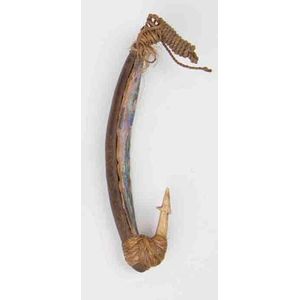Antique Rose Gold Fob Watch with Engine Turned Case
You must be a subscriber, and be logged in to view price and dealer details.
Subscribe Now to view actual auction price for this item
When you subscribe, you have the option of setting the currency in which to display prices to $Au, $US, $NZ or Stg.
- Movement - The technical name for the workings of a clock or watch, and does not include the dial or case.
- Back Plate - On many types of clocks, the movement operates between two plates, usually made of brass, one at the back, and the other at the front, which forms a mount for the dial.
On English bracket, mantle and table clocks the backplate was often visible through a glass door or panel from the late 17th century, and could be profusely engraved with scrolling decorations, flowers, foliage, birds, and figures. The engraving could also include the maker?s name.
The amount of engraving reduced and became simpler as the 18th century progressed, and by 1800, had been reduced to a border, often with the maker's name in the centre. By the early 1800s all decoration had ceased, and only the maker's name was added, and by the Victorian era, most bracket, mantle and table clocks had no engraving. - Engine Turned - Engine turning is a decorative technique used on metal surfaces to create intricate curving or geometric pattern. The process involves cutting a series of lines into the surface of the metal using a rose engine or decoration lathe which rotates the metal as it cuts, allowing the operator to create a repeating pattern that covers the entire surface. The resulting surface has a shimmering, reflective quality that is often described as "engine turned." Where an engine turned item has been enamelled, the term used to describe the decoration is usually guilloche.
Engine turning was originally developed to decorate metal objects such as firearms, scientific instruments, and other metal objects that required precise and elegant design.
This item has been included into following indexes:
Visually similar items

A pair of late 19th century Australian cedar boardroom armchairs, each with a rectangular back upholstered in closed nailed leatherette, above scroll arms and a moulded seat, turned legs and brass castors

Rolex a stainless steel automatic wristwatch with date and bracelet ref 6605 Datejust 1956, Cal. 1065 automatic winding movement, 25 jewels, silvered matte dial, baton indexes, centre seconds, magnified aperture for date, stainless steel Oyster case, reede

B&B; Italia Diesis marble coffee table by Antonio Sittero & Paola Nava. White marble top on chrome frame (Af to one bolted section of marble base)

Pa Kahawai Fishing Lure. A fine, early trolling lure with wooden body; paua-shell 'flashing' inlay to in-curve; bone barb with muka binding and line. Collection number inscribed in black ink: 'Web Col 1538'. Length 13 cm. Width 1.8 cm. Kenneth Athol Webste
